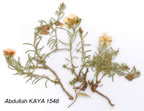| Cistaceae |
 Fumana procumbens |
| Fumana SPACH Fumana procumbens (DUN.) GREN. ET GODR. Ömür: Çok yıllık Yapı: çalı Hayat formu: İlk çiçeklenme zamanı: 5 Son çiçeklenme zamanı: 8 Habitat: kireçtaşı kayalık yamaç, step Minimum yükseklik: 600 Maksimum yükseklik: 1700 Endemik: - Element: ? Türkiye dağılımı: Türkiye Genel dağılımı: Akdeniz, Kırım, Kafkasya Bulunduğu kareler:A2 A3 A4 A7 A8 B2 B3 B4 B5 B6 C2 C3 |
| F. procumbens (Dun.) Gren. & Godr., Fl. Fr. 1: 173 (1848). Syn: Cistus Fumana L., Sp. PI. 525 (1753); C. nudifolius Lam., Fl. Fr. 3: 163 (1788); Helian-themum procumbens Dunal in DC. Prodr. 1: 275 (1824); Fumana vulgaris Spach var. minor Spach in Ann. Sci. Nat. ser. 2, 6: 359 (1836); F. nudifolius (Lam.) Janch. in Öst. Bot. Zeitschr. 58: 396 (1908). Iα: Sweet, Cistineae, t. 68 (1828); Grosser, op. cit. 126, f. 20 D-K (1903). Dwarf, procumbent shrub. Stems puberulent. Leaves exstipulate, alternate, linear, below the lowest flower (5-)10-16(-20) per inch, scarcely diminishing above and upcurved at ends of branches. Flowers distant, solitary, 15-20 mm across, pedicels scarcely longer than the subtending leaves and, in fruit, becoming re-curved from the base. Capsules (4-)8-12-seeded, 5-6 mm long, usually remaining closed with seeds retained, finally shed with pedicel and calyx attached. Fl. 5-8. Rocky limestone slopes and steppe, 600-1700 m. Described from S. France, Italy and Crimea. Scattered, but infrequent in the E. A2(E) Istanbul: Kilia, Azn. (as F. ericoides)! A3 Ankara: 10 km W of Beypazari, 880 m, Kühne 180! A3 Bolu: Çağa Göl. to Bolu, 1150 m, D. 39062! A4 Kastamonu: 5 km W of Kastamonu, 900 m, D. 38766! A7 Trabzon: Maçka, 690 m, Balls 1618! A8 Çoruh: Artvin, Radde. B2 Kütahya: Emet, 1100 m, D. 36552! B3 Konya: Akşehir, 1100 m, Bornm. 1899: 4122! B4 Ankara: Hasanoğlan nr. Ankara, 1180 m, K. Bilger 307! B5 Kayseri: Kisge, Bakir Da., 1400 m, D. 19319! B6 Seyhan: Saimbeyli, 1100 m, D. 19877! C2 Denizli: Denizli, Reese. C3 Burdur: Bucak, 900 m, Little 173! C6 Gaziantep: Gaziantep, Post Herb. Centred in the Mediterranean area, but extending north to S. Sweden, Crimea & Caucasia, and E to Khorassan. In addition to the indumentum character, F. procumbens differs from F. paphlagonica in the dehiscence of the capsule. In this species, the capsule usually remains closed, retaining the seeds within, and abscission is at the base of the pedicel. |